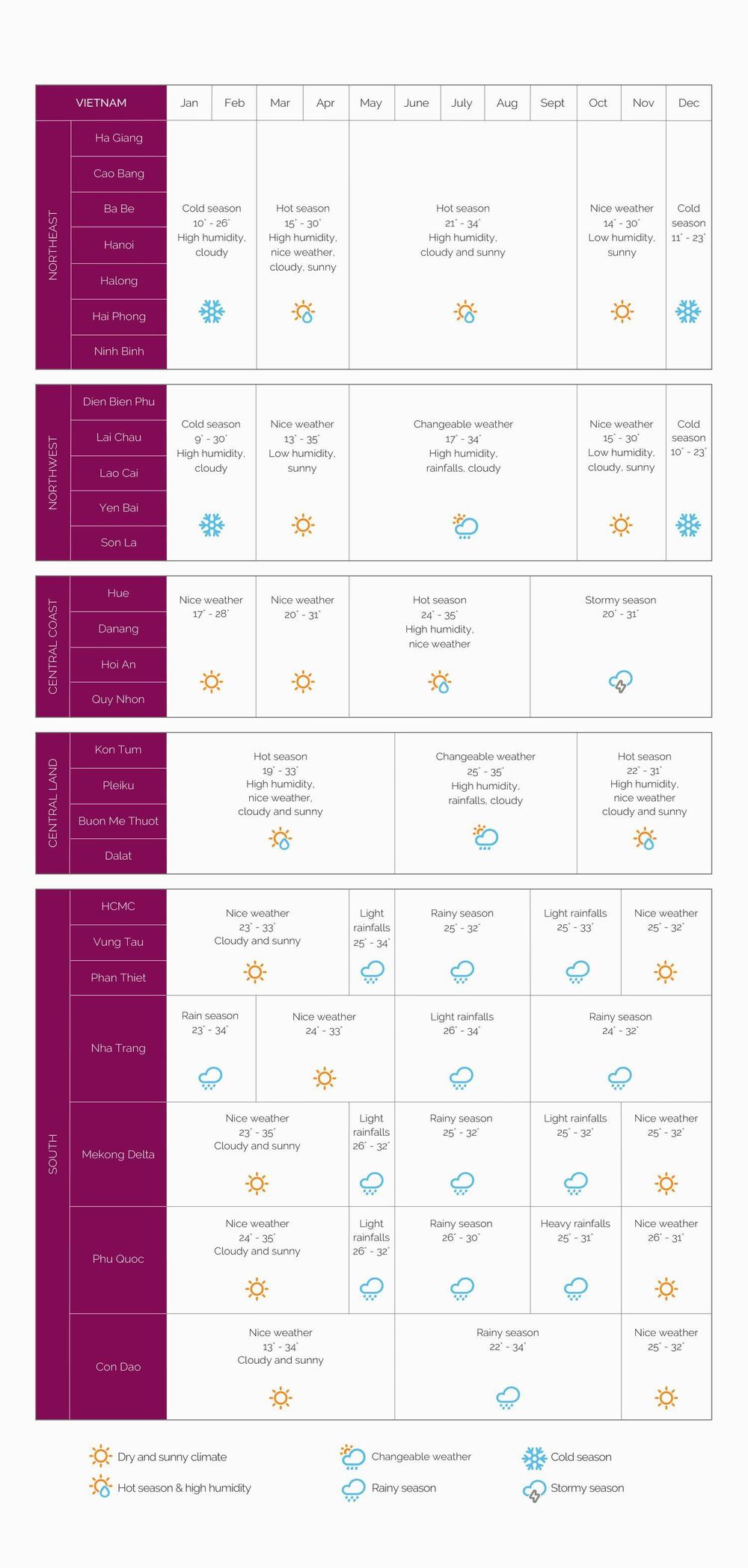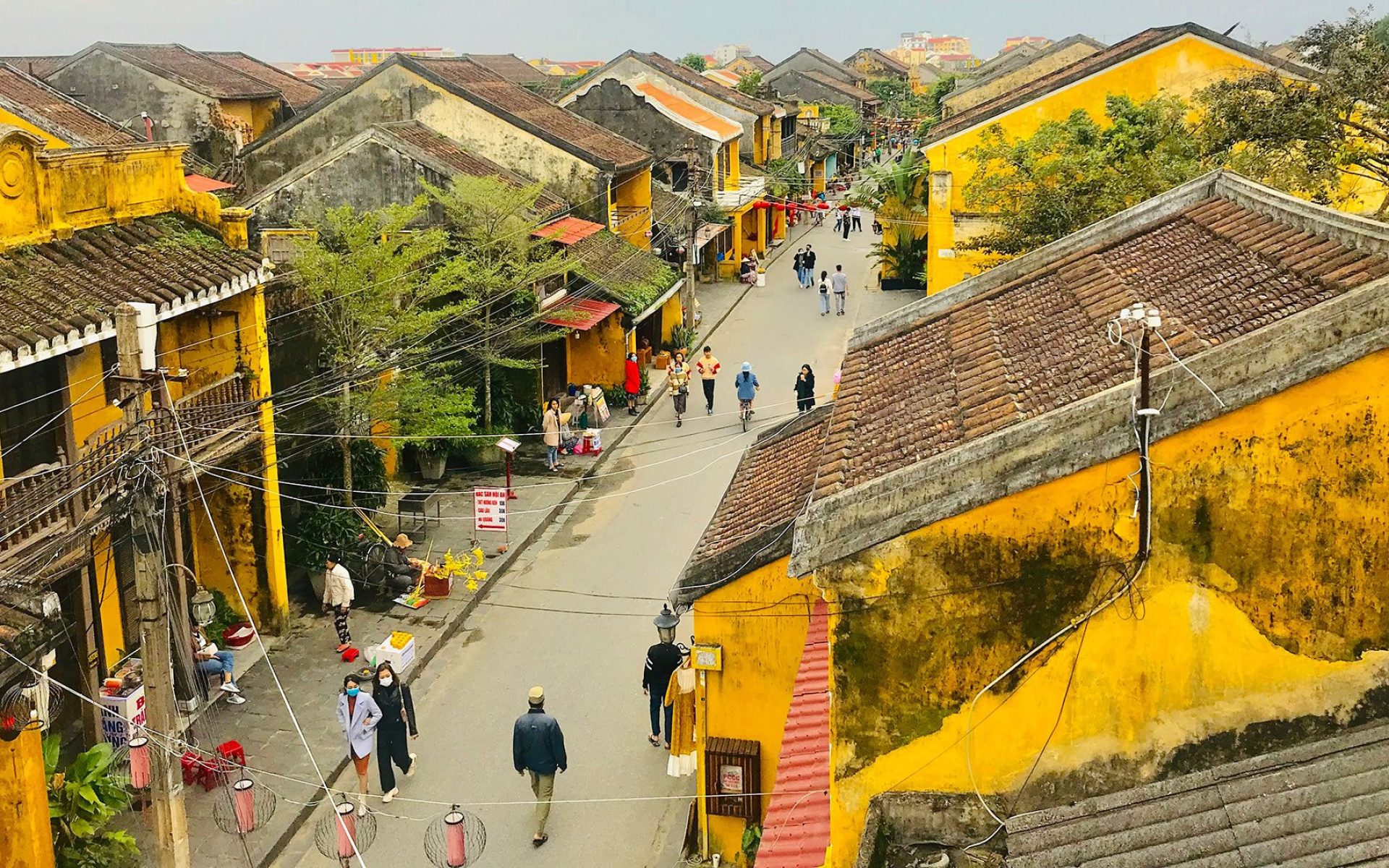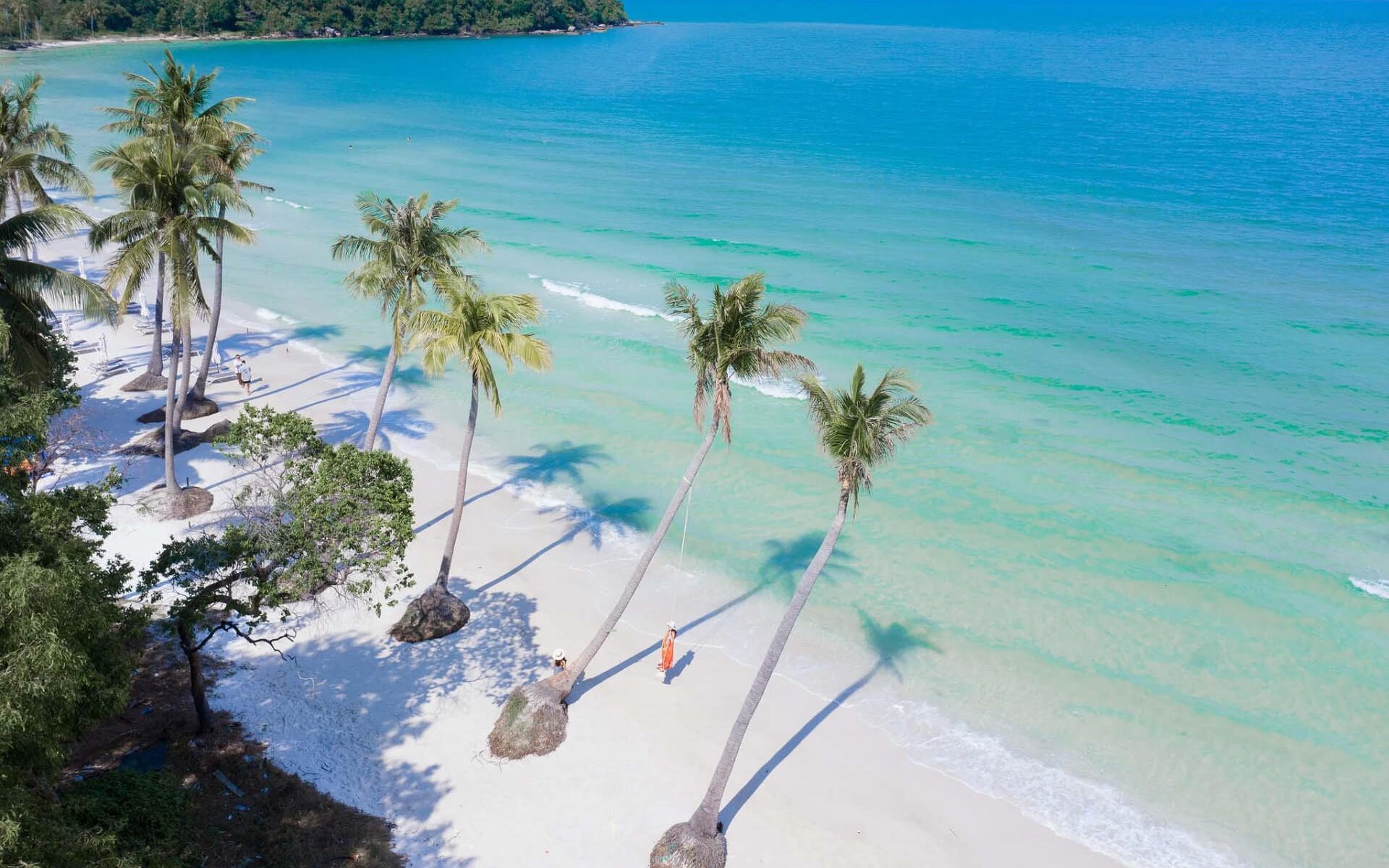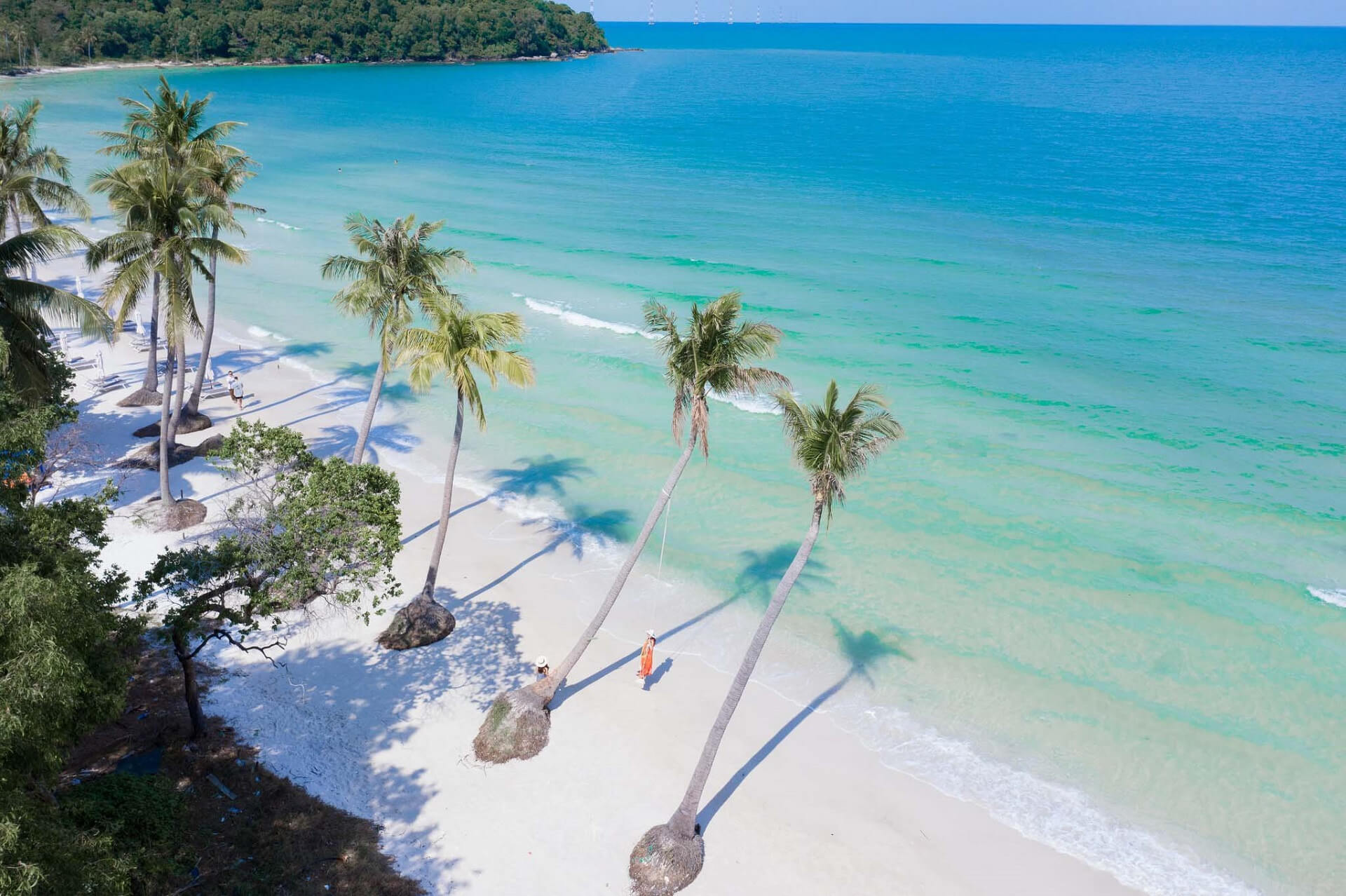Overview of Vietnam weather
- Average temperature: 27 °C (81 °F), varies by region and season.
- Average humidity: 84%, varies by region and season.
- Average rainfall: 1,800 mm (71 inches), varies by region and season.
- Average sunshine duration: 2,000 hours per year, varies by region and season
- Average wind speed: not available.
- Wet Season: May to September in most of the country, influenced by the southwest monsoon.
- Hot Season: April to August in most of the country, with high temperatures and humidity.
- Dry season: October to March in most of the country, with low humidity & rainfall
- Cool Season: November to February in most of the country, influenced by the northeast monsoon.
- Monsoon season: characterized by the distinct monsoon seasons and by regions

Vietnam’s weather is very diverse by region and season due to the great distance from north to south. Vietnam extends from the mountainous Van Don province to the north, and 1600 km down to the south, to the mouth of the lush Mekong Delta. It is seasonally influenced by the monsoons, which bring different weather patterns to different parts of the country.
Vietnam thus has both subtropical and tropical climates. In northern Vietnam’s mountainous areas, on the border with China, the locals experience the temperatures approaching the freezing point and even witness snow on top of the country’s highest mountain Fansipan at Sapa or Mau Son peak in Lang Son. In South Vietnam, on the other hand, you will encounter classic warm equatorial climates.
The East Sea (South China Sea) has a profound effect on the humid monsoon tropical nature of the mainland. The humid monsoon tropical climate is not heterogeneous throughout the territory of Vietnam, forming different climatic regions. Vietnam’s climate changes seasonally and from low to high, from north to south and from east to west. Due to the strong impact of northeast monsoons, the average temperature in Vietnam is lower than that of many other countries of the same latitude in Asia.
Weather by regions
Weather in Northern Vietnam
Most highlighted destinations in Northern Vietnam: Hanoi, Halong, Ninh Binh, Mai Chau, Sapa, Hagiang
Northwest Vietnam: Dien Bien, Hoa Binh, Lai Chau, Lao Cai, Son La, Yen Bai
Northeast: Bac Giang, Bac Can, Cao Bang, Ha Giang, Lang Son, Phu Tho, Quang Ninh, Thai Nguyen, Tuyen Quang
Red River Delta: Bac Ninh, Ha Nam, Hanoi, Hai Duong, Hai Phong, Hung Yen, Nam Dinh, Ninh Binh, Thai Binh, Vinh Phuc
December – February: 10-20 degrees, winter day, rarely rain, possibly snowy in some mountainous areas.
March – April: 18-32 degrees, warm with days of sunshine and days of cloudy, rarely rain.
May – July: 25-40 degrees, a number of days of sunshine, occasional downpours
Aug – September: 25-32 degrees, a number of days of sunshine, occasional downpours & tropical storms
October – November: 22-30 degrees, autumn season with mild temperature, dry weather.
The climate of Northern Vietnam in winter is unusually cool for the latitude. The average temperature in January is below 20 °C (68 °F). In Hanoi, the average is 17.5 °C (63.5 °F), and it’s around 14 °C (57 °F) in the northernmost areas, where the temperature at night can approach freezing (0 °C or 32 °F) between December and January.
From May to August, it’s summer, also the rainy season when the weather becomes hot and humid, with downpours more often in the afternoon or evening.
The wettest months, for example in Hanoi, are July and August, with about 300 mm (12 in) of rain per month. The maximum temperature in Hanoi is 41.3 °C (91 °F), however, due to the humidity, the heat becomes annoying. Sometimes, it can reach high at 37/38 °C (99/100 °F), with peaks of 40/41 °C (102/104 °F) in May and June.
In September/October and November, a quite pleasant period of the fall comes when the monsoon withdraws, before the return of cool and dull weather in December.
In mountainous areas, winter is fairly cold with the average temperature in January is around 8 °C (46.5 °F). The highest peak is Fansipan at 3,143 meters high or Mau Son mountain peak at 1,541 meters high, which is recorded with snow in winter.
The climate in the North of Vietnam often suffers from bad weather impacts. On average, there are 6 to 10 storms annually and tropical depressions cause floods, which strongly affects the life and agriculture sector of the whole locality in the region.

Hanoi train street with bustling cafe shops
Hanoi Weather
December – March: cool to cold, misty, cloudy
April – May: warm to hot, clear skies, sunny
June – August: hot, humid, rainy
September – November: cool, clear skies, sunny
The best time to visit Hanoi is usually from March to May or from September to December. From April to May, the days are normally hot, occasionally above 30 degrees with clear skies. September to November sees cooler temperatures of around 25 degrees and sunny skies – perfect for exploring the capital.
If you’re coming to Hanoi in summer time (May to August), expect soaring temperatures with humidity highs of 40 degrees, and the rainy season is full swing . Early December is cool, misty and atmospheric, however from late December until early March temperatures are surprisingly cold with lows of 10 degrees.
Halong Weather
December – March: cool to cold, misty, cloudy
April – May: warm to hot, clear skies, sunny
June – August: stormy, hot, humid
September – November: mix of sun and clouds, warm to cool
If you’re coming to Halong Bay, try to visit from April to June or October to early December. You’ll have a better chance of enjoying sunny skies and pleasant temperatures.
Other times of year, downpour or heavy mist is common, and tropical storms can sometimes cause cruise cancellations. However, if you’re on the water during this time you can experience a more mystical side of Halong Bay, with its famous karsts shrouded in mist. Temperatures in January can be frigid, so be sure to bring warm layers.

Halong bay view from above
Sapa Weather
December – March: chilly, misty, cloudy, dry
April – June: warm, clear skies, sunny
June – August: hot, humid, clear skies, sunny
September – November: cool, clear skies, dry
Vietnam’s Northern destinations such as Sapa have a much cooler climate than the rest of the country, particularly from late December until March it turns deeply cold . Sapa sees the occasional snowfall in January, so be prepared with warm jacket. Hotels in the area are equipped with heated blankets and local spas offer herbal baths for you to soak in and warm up.
Sapa is near-perfect in late April, as flowers bloom and skies are clear. Late Autumn until early October is also lovely, as its adorable rice terrace turns golden just before harvest.
Weather in Central Vietnam
Most highlighted destinations in Central Vietnam: Hue, Danang, Hoian, Quang Binh, Nhatrang, Dalat, Mui Ne
North Central: Ha Tinh, Nghe An, Quang Binh, Quang Tri, Thanh Hoa, Thu Thien-Hue
South Central Coast: Binh Dinh, Binh Thuan, Danang, Khanh Hoa, Ninh Thuan, Phu Yen, Quang Nam, Quang Ngai
Central Highlands: Dak Lak, Dac Nong, Gia Lai, Kon Tum, Lam Dong
September- December: 17-25 degrees, rainy season with occasional tropical storms
January – March: 20-27 degrees, cool, cloudy, dry
April – August: 25-36 degrees, warm to hot, sunny, clear skies, occasional rains
In the last quarter of the year, because of monsoons blowing in the northeast direction and bringing steam from the sea, the North Central area is affected by cold weather accompanied by rain and occasional storms.
In the second and third quarters of year, there is no steam coming from the sea, but the southwest monsoon (also known as Laos wind) blows upwards, causing dry and hot weather. These months, the temperature can reach its peak heat with over 40 degrees Celsius. Meanwhile, the humidity in the air is very low.
In South Central Coast Region, the northeast monsoon usually weakens when blowing here because it is blocked by the Bach Ma mountain range. Therefore, in summer, when the southwest monsoon occurs strongly from the Gulf of Thailand and overflows the Truong Son mountain range, it will cause dry and hot weather for the entire area. The rainy season usually occurs from October to December.
Located in the Tropical Savanna, the climate in the Central Highlands is divided into two seasons: the rainy season from May to the end of October with the wettest months in July/August, and the dry season from November to April, in which March and April are hottest and driest months. Due to the influence of altitude, the climate of the highlands at 400-500m high is relatively cool and rainy while in the highlands over 1000m, the climate is cool all year round, characteristic of the high mountain climate.
Hue weather
September-February: cool to cold, rainy, cloudy, varies with occasional tropical storms
March-August: warm to hot, sunny, clear skies
Hue, home of Vietnam’s last reigning dynasty, has a late rainy season, with storms and days that are wet and cool from September to February. Look out for occasional flooding from September to November. In the early months of the year, temperatures go down to 15 degrees, and January often sees a bit of mist. The rest of the year is dry, and in July you’ll have perfect beach weather, with highs of 35 degrees.

Dragon cruise along Perfume river in Hue
Danang weather and Hoian weather
September – January: rainy, cool, cloudy, varies with occasional tropical storms
February – August: warm to hot, sunny, clear skies
Hoian is one of the country’s picture-perfect places, but starting in September, tropical storms hit Central Vietnam hard. March and April is an excellent time to see Hội An when the fields, gardens and streets are awash in bright blossoms and soothing greens. From May to August, the town experience the hot weather, and you’ll want to head to the beach to cool off. In the late months of the year, from September to November, Hội An sees a lot of rain and even a few small floods. The temperatures begin to dip and reach their coldest point in January, warming up just before the Vietnamese new year.

Pedestrian streets in Hoian ancient town
Weather in Southern Vietnam
Most highlighted destinations in Southern Vietnam: Ho Chi Minh (Saigon), Mekong delta, Can Tho, Phu Quoc, Con Dao
Southeast: Ba Ria-Vung Tau, Binh Duong, Binh Phuoc, Dong Nai, Ho Chi Minh City, Tay Ninh
Mekong River Delta: An Giang, Ben Tre, Bac Lieu, Ca Mau, Can Tho, Dong Thap, Hau Giang, Kien Giang, Long An, Soc Trang, Tien Giang, Tra Vinh, Vinh Long
May to November: rainy season affected by monsoon, high humidity
December to April: dry season, minimal rainfall,
The South is located in the typical region of tropical monsoon and sub-equatorial climate, rich humid background, abundant sunshine, long radiation time, high temperature and total temperate accumulation. The annual average humidity ranges from 80 to 82%.
The climate is formed in two main seasons all year round, the dry season and the rainy season. The rainy season is from May to November, the dry season is from December to April. The production season is different from the Northern Delta region.
During the rainy season, the city encounters a lot of rainfall and high humidity levels (at about 83%). Rains are typically brief, followed by extended periods of dry, sunny weather. However, the wet season can also bring about intense storms and flooding. It is essential to be aware of these weather dynamics to ensure a seamless travel experience.
On the other hand, the dry season stands out as the best time to explore Ho Chi Minh City. Characterized by minimal rainfall and dry conditions, this period offers convenient travel opportunities to various destinations. April marks the peak of heat during this season, while December brings cooler temperatures.
Due to the general climate change phenomenon, the Southern Delta in the coming time may be greatly affected by the exhaustion of water resources in rivers, especially the Mekong River. According to scientists, by 2070, weather changes in the region will affect the water resources of the Mekong Delta, mainly through small and medium rivers, the flow will be reduced.
Ho Chi Minh city & Mekong delta Weather
May to November: sporadic rainfall, hot, humid
December to April: clear skies, hot, sunny
Southern Vietnam and Ho Chi Minh City have consistent temperatures year-round with average around 30 degrees, with sunshine.
The ideal months for visiting Ho Chi Minh City extend from December to April, constituting the dry season. This timeframe offers enhanced opportunities to explore the city, in contrast to the monsoon season, spanning from May to November.
Phu Quoc island Weather
July – September: stormy, hot, humid
October – June: clear skies, hot, sunny
The island of Phú Quốc has some of Vietnam’s best beaches and promises balmy weather year-round. However, you might want to avoid visiting in the rainy season, from July through September. During these months some storms roll through, making ferrying dangerous and the beaches less than ideal. The rest of the year is hot and dry, and Phú Quốc is a sublime tropical escape in December and January.

Bai Sao beach in Phu Quoc island
Con Dao island Weather
November – February: dry, windy, monsoon with occasional strong wind
October – December: cool, dry
March – May: sunny, calm sea, hot
June – September: sunny, rainy, humid (endangered turtles laid eggs)
Con Dao is a year-round destination offering diversified activities for everyone. Whether you’re seeking adventure, discovery, relaxation, or an opportunity to connect with nature, Con Dao will always delight and surprise you.
From March to May, it’s an ideal time to indulge in water activities such as snorkeling, diving, and swimming. This is the best time to explore Vietnam’s best coral reefs.
Early months of the years, from January to February when it offers cooler and dry weather, it is a perfect time for some adventure tours such as hiking and trekking through the lush rainforests, visiting historical sites, or simply lounging on the sandy beaches.
Endangered turtles comes to the island to lay eggs from April to October and hatch from May through December, when is the right time for nature lovers and discovery.
Nhatrang Weather
September to December: cool, rainy, cloudy
January – August: hot, sunny, clear skies
Nha Trang gets the more than 300 days of sunshine per year, the most out of the whole country. Some monsoons hit between September and December, but in general Nha Trang has the shortest rainy season in Vietnam. Most of the year, the city has a pleasant temperature, with cooling sea breezes, although you should expect lots of sun and hot days from July until August.
Dalat Weather
April – October: rainy, warm to hot, cloudy
November – May: cool to cold, dry, clear skies
Nestled in the central highlands, this charming mountain city is appreciated for its temperate climate. The air in Da Lat is always fresh and crisp. The mountains provide consistent cool temperatures and pleasant breeze, making it a great spot to escape the heat of the cities. Da Lat’s rainy season is from April until October. Temperatures are generally consistent with lows of 20 degrees in January and highs of 30 degrees in July.
 Travelers can travel to Vietnam all year around
Travelers can travel to Vietnam all year around
Best time to visit Vietnam
As you can see that the weather in Vietnam is split by region, therefore, there is no exactly best or worst time to visit Vietnam, with travel possible all year. High season often comes from October to April when the weather seems to be the best with dry, cool, even cold atmosphere and less rain. However, low season (May to September) is still in favorite choice due to many sunny days and blue sky. Although rain in low season can cause more or less inconvenience to each visitor while traveling, good deals and promotions from hotels and tour operators are still appealing to a number of travelers.
When the North is hot and humid with high rainfall during May to September, then the weather becomes cooler and dry in October to April. Especially, in the far North, December and January can be particularly cold.
While the optimal time to visit Vietnam for pleasant weather is typically from November to April of the following year, the prime period to explore the country is from March to April. During this time, rainfall is minimal and temperatures are more moderate. In a country more than 1,600 kms (1,000 miles) long, the weather in Vietnam varies considerably as you go from north to south, from a temperate to a tropical climate.
Central Vietnam experiences hot, dry weather between January & August when temperatures can hit the mid-30°C’s; whilst high levels of rainfall can occur in September, October & November.
Southern Vietnam is generally dry and hot from November to April, and warm and wet between May & October, with the highest rainfall in June, July & August.
In conclusion, Vietnam is a beautiful destination that draws visitors all year round thanks to its lively atmosphere, idyllic beaches and wonderfully tropical climate. Decision on travelling time to Vietnam will definitely be up to your choice depending on what type of weather you love, what you want to do, and how much (or how little) you’re into crowds. Each weather type has its own strength and advantages which can probably surprise you when exploring the whole country through the North to the South.
Contact Vietnam Heritage Travel today to get a free consultation regarding tour itineraries and quotations. We are more than happy to assist 24/7!



Comment (0)